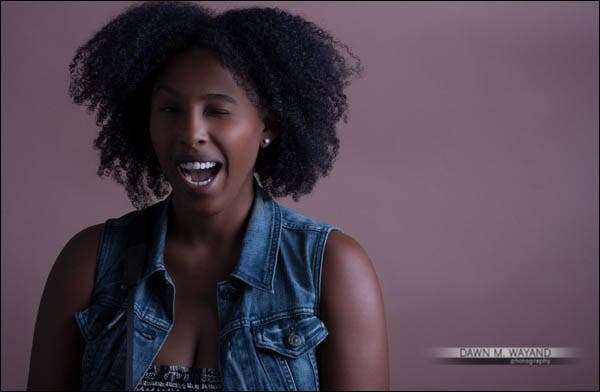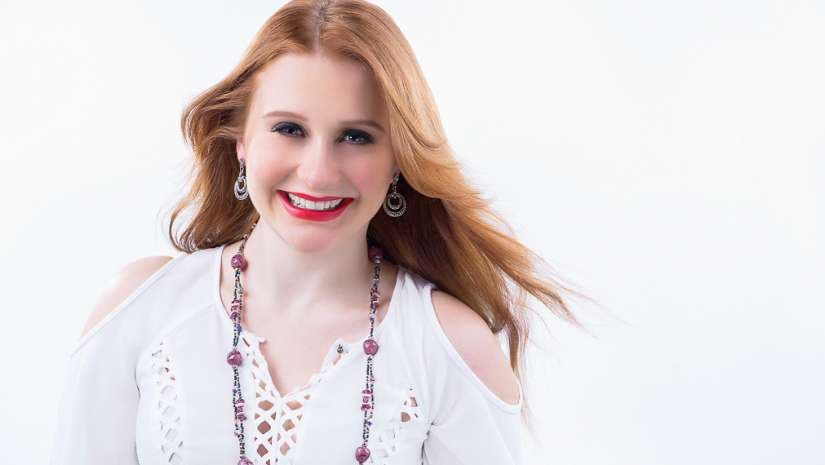The most important element of a portrait is your subject. Yes, composition and depth of field adds to a portrait, and backgrounds and lighting can make or break one, but without a subject, there is no portrait.

The biggest key to a great portrait is your subject.
Model: Kathryn Hopkins
We started off this series discussing Composition, Depth of Field and Background and in our last article, we covered Light. In this article, I’m going to go over the feature of a portrait: your subject.
GETTING TO KNOW YOUR SUBJECT
The best thing you can do before a portrait shoot is to sit down with your subject for at the very least: 10 minutes – and talk with your subject. Get to know them a little better. Where are they from and in some cases, what country are they originally from? What’s their favorite color? What kind of music do they enjoy? (This can often help by using a service such as Spotify or even Apple Music to play the music your client likes during a portrait shoot to get them to relax, which we will get into later…) Do they have hobbies? What do they do for fun?

Using your subject’s unique qualities expresses who they are in a portrait.
Model: Maria Iodice
The list of potential questions is endless, and the benefit to getting these types of questions answered is this: the more you know about your subject, the more your can bring your subject into their portrait. For the image above, my client above told me about her ethnic background so we played around with some scarves to capture more of the essence of who she is and where she’s from.
THEIR CHARACTER
Sometimes you might have a quiet, reserved teen to photograph and other times you might have to capture a more extroverted, animated subject. Getting to know their character when you have that initial chat before you pick up your camera will prepare you for what you want to capture about that person. You wouldn’t want to force a smile on someone who rarely smiles just as much as you wouldn’t want to force a serious expression on someone who is always smiling and laughing.

A portrait should express a person’s character.
Model: Chelsea Jackson
The idea is to capture your subject as the person he or she actually is rather than portraying them as someone they are not. In the image above, my subject was a carefree, extroverted girl and she naturally gave me this expression which completely shows the fun, carefree woman she truly is.
GETTING A SUBJECT TO RELAX
Getting a subject to relax can be a tough one, but it doesn’t have to be if you have a few tricks up your sleeve. Again, getting to know your client before a photoshoot will not only only give your client better images in the long run, but it will help you to actually capture those images! Learn what kind of music they like and then play their favorite singer or band’s music very subtly in the background during a shoot.

Getting a subject to relax can be hard – or not – once you learn how to do it.
Model: Lizbeth Sawyers
Sometimes giving a subject something to do with their hands relaxes them. The common cause a subject might have for not being able to relax is just not knowing what to do in front of a camera. Use a soft, friendly voice. Be very specific with your direction. Talk to your subject. Remember all those questions you asked in the beginning? Ask away as they more you are interacting with your subject, the more relaxed they become in front of your lens and you with your subject.
POSING
Facial Expressions
A facial expression can be one of those things that makes a breaks a portrait. If your subject is not relaxed in front of your lens, it will show in their face, whether it’s tension in the forehead or around the mouth or a deer in headlights look in their eyes. Even when you are shooting models, a problem can arise with getting a good facial expression in an image.

Facial expressions are key.
Model: Alexandra Rosner
Knowing how to relax your subject and getting them to connect with you personally (directly behind the lens) rather than just connecting with that long black thing in their face (your lens) can make all the difference. As you can see in the image above, my subject has no tension in her forehead, her eyes are soft and her mouth is relaxed.
Body Language
Posing the body to express what you want to express in a portrait is probably one of the more easier tasks than dealing with facial expressions. A person can be feeling a certain way on the day of their shoot and it’s more difficult to get a good facial expression out of them that is more natural to their usual personality. Getting a subject to pose their body is a bit easier sans posture. A person having a bad day may have a more slouched look or poor posture. You’ll want to make sure to observe and correct this before pressing the shutter. You can tell a subject how to pose, or even more effective: mimic a pose to a subject and then walk over to adjust them as necessary.

Body language can tell a story in and of itself in a portrait.
Model: Baron Jackson
In the image above, I was looking for a bad boy, musician type look, so I needed a more serious expression. I used a hand in the pocket and the other hand posed upward grabbing his shoulder to exude a more confident look.
Hands
Hands can be a little difficult to work with sometimes, but again, if you know a few tricks, they do not have to be. For women, the idea is for a woman to look feminine: soft, gentle, light, beautiful and graceful. So let’s create graceful hands! A good trick for this is to have them start with their hands at the top of their head and have them lightly sweep their fingers very lightly, gently and SLOWLY downward “like a feather”, across and/or in any other direction. Keep clicking the shutter while their fingers are in motion, or tell them to “hold” once their hands/fingers get to a place where you want to create the capture.

The use of hands.
Actor: Patrick Walsh
For men, it become a little bit easier. Men can use their hands to engage with their facial hair, their hands can be placed in their jean pockets and/or they can even tuck their hands under their arms when you have them cross their arms. (When they do that, sometimes a good trick is to have them push their hands forward a little as it can bulge the biceps a little more…)
Eye Contact
I’m sure you’ve heard the saying, “the eyes are the window to a person’s soul”. Capturing your subject with direct eye contact can be very engaging to a viewer looking at a finished image. For this reason, the eyes should be the sharpest part of a portrait.

Direct eye contact.
Model: Daria Komarkova
However, sometimes catching your subject with their eyes focused on something off-camera, can be just as engaging. It makes you wonder, what they are looking at? What are they thinking? Typically a candid portrait will usually have eyes focused on something else off-camera because they are engaged with something else, making the image “candid”.

Eyes directed off-camera.
Model: James Karl Campbell
CANDID PORTRAITS
Many people will opt for nabbing a candid portrait. A candid portrait is one where your subject is not really in an intentionally posed position. Some photographers like this because they feel a subject is more at ease and being themselves during a candid moment. Others like the feel of a look into someone’s everyday life. Whether I’m shooting fashion or portraits in a studio or outdoor setting, I keep shooting whether I’m posing a subject or not. It’s only then I will capture a moment of laughter, or a deep moment like in the image below.

Catching someone off guard sometimes makes for an interesting portrait.
Model: James Karl Campbell
In the image above, after shooting a long day with my model, we took a break for a few moments and I managed to catch him staring into the light. I have to admit a “candid” portrait wasn’t the first thought on my mind when I captured this portrait. It was more his expression of being deep in thought during a period of silence and the reflection of the light in his eyes.
MOTION & MOVEMENT
Introducing motion or movement into a portrait can add vibrancy and flair to a portrait. You might be shooting an athlete or a dancer or even a moving child. Having a hint of motion in the image adds a dynamic element to a portrait that help differentiate your portrait from other portraits.

Introducing movement into an image can make a portrait breathtaking.
Model/Dancer: Shoko Fujita
In the portrait of the dancer above, the dancer was moving slowly, however, I was also shooting her through a piece of Plexiglas covered with folded Saran wrap to get an added effect of motion, creating a more soft, elegant and whimsical ballerina portrait.
INTRODUCING PROPS
Props can be key in not only getting your subject to relax or adding in a talent of your subject, but they can also help to tell a story with your subject as the main character. Sports equipment, musical instruments and more can lend to adding an interesting storyline to the life of your subject through an image.

A little rug, a few pillows, lighting some candles and giving a girl a guitar gets you right at home with the artist.
Model: Daria Komarkova
In the image above, I wanted to go for an “at-home-with-the-artist” feel so I rolled out a faux wooden floor, laid down a comfortable rug, threw down a few warm-colored pillows, lit a few candles, and gave my rock-n-roll subject a guitar to strum while shooting her from above.
IT’S ALL ABOUT WHAT’S RIGHT IN FRONT OF YOU…
So really, a good part of a good portrait relies a lot on your subject and how you interact and place them in a frame. You now know how important talking to a subject is prior to a portrait shoot as it affects so many subsequent parts of that shoot. Posing is important and catching your subject off-guard in a candid moment can be just as wonderful. Mix in a prop here and there to speak a volume about your subject’s talents and/or to tell their story and you have an amazing portrait!






